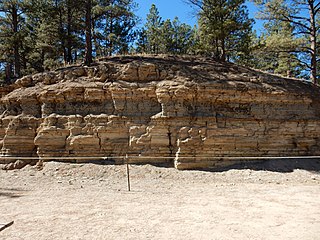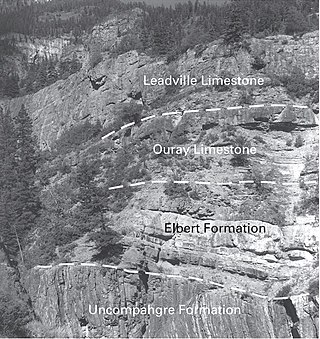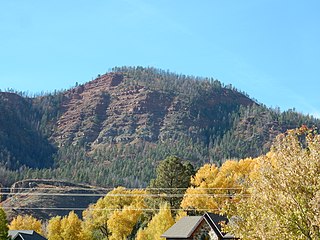| Creede Formation | |
|---|---|
| Stratigraphic range: Oligocene (Chattian) | |
| Type | Formation |
| Lithology | |
| Primary | Lacustrine |
| Location | |
| Region | Colorado |
| Country | United States |
The Creede Formation is a geologic formation in Colorado, United States. It preserves fossils dating back to the Paleogene period, particularly many well-preserved fossil plants from Oligocene strata. [1]

The Florissant Formation is a sedimentary geologic formation outcropping around Florissant, Teller County, Colorado. The formation is noted for the abundant and exceptionally preserved insect and plant fossils that are found in the mudstones and shales. Based on argon radiometric dating, the formation is Eocene in age and has been interpreted as a lake environment. The fossils have been preserved because of the interaction of the volcanic ash from the nearby Thirtynine Mile volcanic field with diatoms in the lake, causing a diatom bloom. As the diatoms fell to the bottom of the lake, any plants or animals that had recently died were preserved by the diatom falls. Fine layers of clays and muds interspersed with layers of ash form "paper shales" holding beautifully-preserved fossils. The Florissant Fossil Beds National Monument is a national monument established to preserve and study the geology and history of the area.

Paleontology in Colorado refers to paleontological research occurring within or conducted by people from the U.S. state of Colorado. The geologic column of Colorado spans about one third of Earth's history. Fossils can be found almost everywhere in the state but are not evenly distributed among all the ages of the state's rocks. During the early Paleozoic, Colorado was covered by a warm shallow sea that would come to be home to creatures like brachiopods, conodonts, ostracoderms, sharks and trilobites. This sea withdrew from the state between the Silurian and early Devonian leaving a gap in the local rock record. It returned during the Carboniferous. Areas of the state not submerged were richly vegetated and inhabited by amphibians that left behind footprints that would later fossilize. During the Permian, the sea withdrew and alluvial fans and sand dunes spread across the state. Many trace fossils are known from these deposits.
The North Park Formation is a geologic formation in Colorado. It preserves fossils dating back to the Neogene period.
The Dotsero Formation is a geologic formation in Colorado. It preserves fossils dating back to the Cambrian period.
The Sawatch Formation is a geologic formation in eastern Colorado. It is a sedimentary sequence formed approximately 530 million years ago during a marine transgression. It preserves fossils dating back to the Cambrian period. It is composed of glauconitic and quartz-rich sandstone.
The Battle Mountain Formation is a geologic formation in Colorado. It preserves fossils dating back to the Carboniferous period.

The Minturn Formation is a geologic formation in Colorado. It preserves fossils dating back to the Carboniferous period. Among the fossils preserved are of crinoids, spiriferid brachiopods, gastropods, and the spines and teeth of numerous sharks such as Petalodus.
The Dyer Formation is a geologic formation in Colorado. It preserves fossils dating back to the Devonian period.

The Ouray Formation is a geologic formation in Colorado. It preserves fossils dating back to the Devonian period.
The Browns Park Formation is a geologic formation in Colorado. It preserves fossils dating back to the Neogene period.
The Troublesome Formation is a geologic formation in Colorado. It preserves fossils dating back to the Neogene period. It consists of Pale shades of pink, tan, gray, green, and white interbedded siltstone and mudstone, less abundant arkosic sandstone and conglomerate, and sparse limestone and altered crystal-vitric ash and tuff; generally poorly consolidated. It includes atypical deposits containing abundant pink, granitic cobbles and boulders along the western parts of the outcrop in the west-central and southwestern parts of the Granby Quadrangle, Fossil mammals from three sites indicate a late Oligocene age.
The Harding Sandstone is a geologic formation in Colorado. It preserves fossils dating back to the Ordovician period.
The Manitou Limestone is a geologic formation in Colorado. It preserves fossils dating back to the Ordovician period.
The Farisita Formation is a geologic formation in Colorado. It preserves fossils dating back to the Paleogene period.

The Huerfano Formation is a geologic formation in Colorado. It preserves fossils dating back to the Paleogene period.
The Middle Park Formation is a geologic formation in Colorado. It preserves fossils dating back to the Paleogene period.
The Animas Formation is a geologic formation in Colorado. It preserves fossils dating back to the Paleogene period.

The Maroon Formation is a geologic formation in Colorado. It preserves fossils dating back to the Permian period. It is the primary formation of sandstone that lends the vivid red color to the hills around Glenwood Springs, Colorado.
The Alamosa Formation is a geologic formation in Colorado. It preserves fossils. The formation was deposited by Lake Alamosa, a paleolake that existed from the Pliocene to the middle Pleistocene.

The Hermosa Group is a group of geologic formations in Utah and Colorado. It preserves fossils dating back to the Carboniferous period.